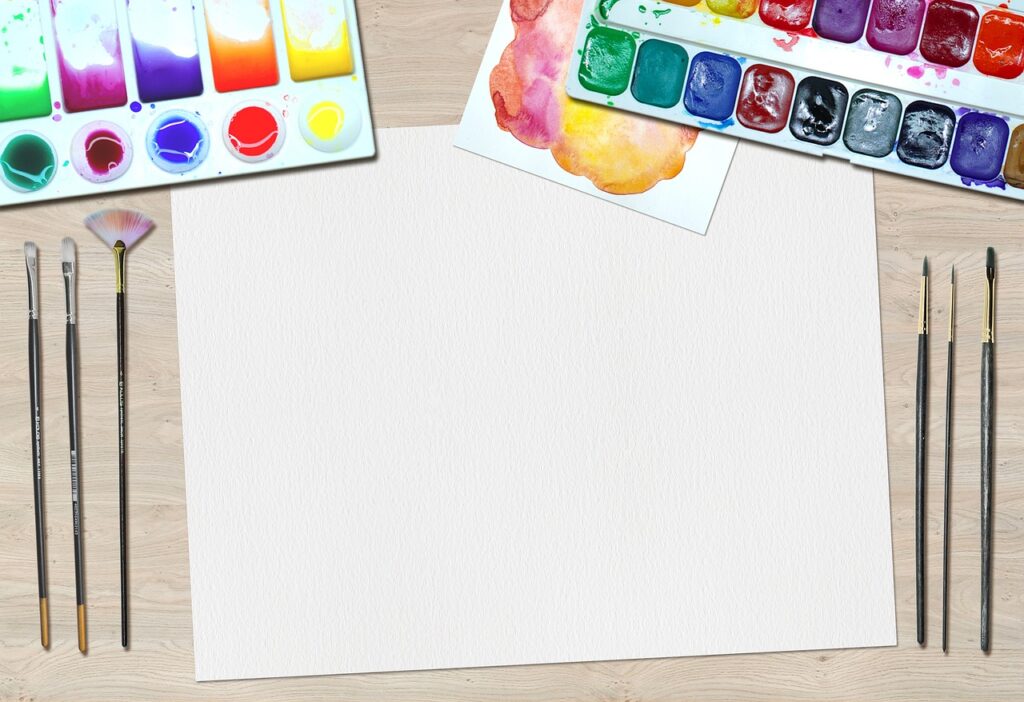For those with a passion for creativity, pursuing a career in art can be incredibly rewarding. While many people associate art careers solely with painting or sculpting, the art world offers a diverse range of professional opportunities that extend far beyond the traditional artist roles. Whether you’re interested in visual arts, digital design, art therapy, or museum curation, there’s an array of career paths to explore that blend creativity with skill and innovation.
This guide will provide an overview of various art-related careers, highlight the educational and skill requirements for each, and offer insight into what to expect in terms of job outlook and salary potential. Whether you’re just beginning to explore the idea of an art career or looking to make a mid-career change, this guide is designed to help you navigate your options and find the path that best aligns with your creative goals and professional aspirations.
Types of Art Careers
The world of art careers is diverse and expansive, offering numerous opportunities for creative individuals to express themselves and make a meaningful impact on society. In this section, we will explore various types of art careers, covering fields such as visual arts, performing arts, design, media and entertainment, and art education and curation.
Visual Arts
Visual arts careers encompass a wide range of disciplines that involve creating and showcasing artistic works. These professions often require a strong foundation in artistic techniques, as well as knowledge of various tools and materials. Some popular visual arts careers include:
Graphic Designer
Graphic designers create visual content for branding, advertising, web design, and print media. They use software like Adobe Creative Suite to design logos, brochures, websites, and more.
- Key Skills: Design principles, typography, digital tools, creativity, communication.
- Education: Degree in Graphic Design or Visual Communication.
- Career Path: Graphic designers can work in-house for companies, in design agencies, or as freelancers.
Art Director
Art directors oversee the visual style and imagery in advertising, magazines, film, and other media. They manage design teams and ensure that the visual elements align with the project’s goals.
- Key Skills: Leadership, creativity, design principles, project management.
- Education: Degree in Graphic Design, Fine Arts, or a related field.
- Career Path: Art directors often start as graphic designers or illustrators and advance into leadership roles in advertising, publishing, or media production.
Animator
Animators create moving images using hand-drawn, 2D, 3D, or stop-motion techniques. They work in film, television, video games, and advertising.
- Key Skills: Drawing, storytelling, proficiency in animation software, creativity.
- Education: Degree in Animation, Graphic Design, or Fine Arts.
- Career Path: Animators work in animation studios, film production companies, or game development firms. Freelance opportunities are also common.
Concept Artist
Concept artists develop visual concepts for characters, environments, and objects in video games, films, and animations. They create the initial designs that guide the production team.
- Key Skills: Drawing, digital painting, creativity, understanding of storytelling and design.
- Education: Degree in Fine Arts, Illustration, or Animation.
- Career Path: Concept artists typically work in the entertainment industry, often in gaming or film studios.
Illustrator for Media and Publishing
These illustrators create artwork for books, magazines, advertisements, and digital platforms. They may work on editorial content, advertising campaigns, or book covers.
- Key Skills: Drawing, creativity, storytelling, digital tools proficiency.
- Education: Degree in Illustration, Fine Arts, or Graphic Design.
- Career Path: Media and publishing illustrators often work freelance, with agencies, or directly with publishing houses.
Performing Arts
Performing arts careers involve the creation and execution of live performances, such as theater, dance, and music. These professions often require a combination of talent, training, and dedication to the craft. Some common performing arts careers include:
- Actor: Performers who portray characters in theater, film, television, and other forms of entertainment. Actors may work on stage, screen, or in voice-over roles, and often collaborate with directors, writers, and other artists to bring stories to life.
- Dancer: Professionals who use movement and physical expression to tell stories and convey emotions. Dancers may perform in various styles, such as ballet, modern, or hip-hop, and often work with choreographers to create and execute routines.
- Musician: Talented individuals who create, perform, and record music using instruments or their voice. Musicians may work as solo artists, as part of a band or ensemble, or in other capacities within the music industry.
Design
Design careers involve the creation of functional and aesthetically pleasing spaces, products, or experiences. These professions require a combination of artistic and technical skills, as well as an understanding of various materials and processes. Some popular design careers include:
Fashion Designer
Fashion designers create clothing, accessories, and footwear. They develop concepts, sketch designs, select fabrics, and oversee the production process.
- Key Skills: Creativity, sewing, pattern making, fabric knowledge, trend analysis.
- Education: Degree in Fashion Design or Textile Design.
- Career Path: Fashion designers work for fashion houses, retailers, or as independent designers. Many also launch their own brands.
Interior Designer
Interior designers plan and design the interiors of residential, commercial, and public spaces. They work on layout, furnishings, color schemes, and lighting.
- Key Skills: Spatial awareness, creativity, technical drawing, color theory, communication.
- Education: Degree in Interior Design or Architecture.
- Career Path: Interior designers work in design firms, for corporations, or as freelancers. Certification and licensure may be required in some regions.
Industrial Designer
Industrial designers develop concepts for manufactured products, including automobiles, home appliances, and electronics. They combine art, business, and engineering to create functional and aesthetically pleasing products.
- Key Skills: Creativity, technical drawing, materials knowledge, CAD software proficiency.
- Education: Degree in Industrial Design or Product Design.
- Career Path: Industrial designers work in manufacturing, design firms, or as consultants. They often collaborate with engineers and marketers.
Jewelry Designer
Jewelry designers create wearable art pieces using metals, gemstones, and other materials. They may work on custom designs or produce collections for retail.
- Key Skills: Creativity, metalworking, gemology, attention to detail.
- Education: Degree or diploma in Jewelry Design or Metalsmithing.
- Career Path: Jewelry designers can work for jewelry brands, create custom pieces, or start their own line.
Ceramic Artist
Ceramic artists create functional and decorative objects from clay. Their work can include pottery, sculpture, and installations.
- Key Skills: Creativity, knowledge of ceramics techniques, attention to detail.
- Education: BFA or MFA with a focus on Ceramics.
- Career Path: Ceramic artists often work independently, sell at galleries and craft fairs, or teach ceramics.
Digital Arts Careers
Digital Illustrator
Digital illustrators create artwork using digital tools for applications in advertising, publishing, and entertainment. Their work is often seen in books, magazines, and online media.
- Key Skills: Digital painting, creativity, storytelling, proficiency with software like Adobe Illustrator and Photoshop.
- Education: Degree in Digital Art, Graphic Design, or Illustration.
- Career Path: Digital illustrators work freelance, for design agencies, or in-house for companies.
3D Modeler
3D modelers create three-dimensional representations of objects, characters, and environments for video games, films, and virtual reality. They use software like Blender, Maya, or 3ds Max.
- Key Skills: 3D modeling, texturing, understanding of anatomy and form, proficiency in 3D software.
- Education: Degree in 3D Animation, Game Design, or Visual Effects.
- Career Path: 3D modelers work in gaming, film production, or architectural visualization. Freelance opportunities are also common.
Video Game Artist
Video game artists create the visual elements of video games, including characters, environments, and special effects. They work closely with game designers and developers.
- Key Skills: Drawing, 3D modeling, animation, understanding of game engines.
- Education: Degree in Game Design, Animation, or Digital Arts.
- Career Path: Video game artists work for game development studios or as freelancers. They may specialize in areas like character design, environment art, or UI/UX design.
Multimedia Artist
Multimedia artists create artwork that combines multiple forms of media, including video, audio, animation, and interactive elements. Their work is often used in advertising, entertainment, and education.
- Key Skills: Creativity, proficiency in multimedia software, storytelling, technical skills.
- Education: Degree in Multimedia Arts, Digital Media, or a related field.
- Career Path: Multimedia artists work in advertising agencies, production companies, or as independent artists.
Web Designer
Web designers create the visual layout and user interface of websites. They focus on aesthetics, usability, and functionality to ensure a positive user experience.
- Key Skills: Web design principles, HTML/CSS, UI/UX design, creativity.
- Education: Degree in Web Design, Graphic Design, or a related field.
- Career Path: Web designers work in design agencies, for companies, or as freelancers. They often collaborate with web developers and content creators.
Media and Entertainment
Media and entertainment careers involve the creation, production, and distribution of various forms of art and entertainment, such as movies, television shows, and video games. These professions often require a mix of artistic, technical, and organizational skills. Some popular media and entertainment careers include:
- Animator: Artists who create moving images for various media, such as film, television, and video games. Animators may work with traditional hand-drawn techniques or digital tools, and often collaborate with other professionals, such as directors, writers, and sound designers.
- Film and Television Producer/Director: Professionals who oversee the creation and production of movies, television shows, and other audiovisual content. Producers and directors work with a variety of artists and technicians to bring stories to life and ensure a successful final product.
- Game Designer: Creative individuals who design and develop video games for various platforms, such as consoles, computers, and mobile devices. Game designers often work with programmers, artists, and other professionals to create engaging and immersive gaming experiences.
Art Education and Curation
Art education and curation careers focus on the teaching, preservation, and promotion of art and artistic practices. These professions often require a combination of knowledge, passion, and organizational skills. Some common art education and curation careers include:
Art Teacher/Instructor
Art teachers educate students in the principles and techniques of art, from elementary school to college level. They may teach drawing, painting, sculpture, and art history.
- Key Skills: Teaching, creativity, knowledge of art techniques and history, communication.
- Education: Degree in Art Education, Fine Arts, or a teaching credential.
- Career Path: Art teachers work in schools, colleges, art institutions, or community centers. Some also offer private lessons.
Art Therapist
Art therapists use creative expression to help individuals cope with emotional, psychological, and physical challenges. They work in various settings, including hospitals, schools, and private practice.
- Key Skills: Empathy, creativity, understanding of psychology, counseling skills.
- Education: Degree in Art Therapy or a related field, often requiring a master’s degree and certification.
- Career Path: Art therapists work in healthcare settings, mental health clinics, or as private practitioners.
Museum Educator
Museum educators design and implement educational programs and activities for museum visitors. They often work to make art and history accessible to a diverse audience.
- Key Skills: Teaching, communication, creativity, knowledge of art and history.
- Education: Degree in Art History, Museum Studies, or Education.
- Career Path: Museum educators work in museums, galleries, or cultural institutions. They may also collaborate with schools and community organizations.
Curator
Curators oversee the acquisition, care, and display of collections in museums and galleries. They organize exhibitions and conduct research on the artworks and artists.
- Key Skills: Art history knowledge, research, organization, communication.
- Education: Degree in Art History, Museum Studies, or Curatorial Studies; often requires an advanced degree.
- Career Path: Curators work in museums, galleries, and cultural institutions. They may specialize in specific types of art or periods.
Gallery Manager
Gallery managers oversee the daily operations of an art gallery, including sales, marketing, exhibition planning, and artist relations. They work to promote and sell artworks.
- Key Skills: Business management, sales, marketing, art knowledge.
- Education: Degree in Arts Management, Art History, or Business.
- Career Path: Gallery managers work in commercial galleries, non-profit art spaces, or auction houses.
Art Conservator
Art conservators work to preserve and restore artworks, ensuring their longevity. They use scientific methods to analyze and treat art that has deteriorated due to age, environment, or damage.
- Key Skills: Art history, chemistry, fine motor skills, attention to detail.
- Education: Degree in Art Conservation, often requiring a master’s degree.
- Career Path: Art conservators work in museums, galleries, private practice, or conservation labs.
Exhibition Designer
Exhibition designers create the layout and design of exhibitions in museums, galleries, and other spaces. They work to enhance the visitor experience through innovative displays and installations.
- Key Skills: Spatial design, creativity, technical drawing, project management.
- Education: Degree in Design, Architecture, or Museum Studies.
- Career Path: Exhibition designers work in museums, galleries, or as freelancers, often collaborating with curators and artists.

Art Criticism and Writing Careers
Art Critic
Art critics analyze and evaluate art, writing reviews for newspapers, magazines, or online platforms. They provide insights and opinions on contemporary and historical art.
- Key Skills: Writing, critical thinking, art history knowledge, communication.
- Education: Degree in Art History, Journalism, or English.
- Career Path: Art critics work for media outlets, art magazines, or as freelancers. Some may also write books or lecture on art.
Art Journalist/Writer
Art journalists and writers cover art-related news, events, and trends. They write articles, interviews, and features for print and digital media.
- Key Skills: Writing, research, art history knowledge, communication.
- Education: Degree in Journalism, Art History, or English.
- Career Path: Art journalists work for newspapers, magazines, websites, or as freelancers. They may also contribute to art catalogs or exhibition programs.
Art Historian
Art historians research and study the history and development of art. They may work in academia, museums, or write books and articles on art history.
- Key Skills: Research, writing, critical thinking, art history knowledge.
- Education: Degree in Art History, often requiring a master’s or PhD.
- Career Path: Art historians work in universities, museums, cultural institutions, or as independent researchers.
Emerging and Interdisciplinary Art Careers
Interactive Media Artist
Interactive media artists create artworks that engage the viewer in a participatory experience. This can include digital installations, virtual reality, or multimedia projects.
- Key Skills: Creativity, technical skills, knowledge of interactive media, coding.
- Education: Degree in Digital Arts, Interactive Media, or a related field.
- Career Path: Interactive media artists work in galleries, museums, or in the tech industry. They may also work on commissions for public art projects.
Virtual/Augmented Reality Artist
VR/AR artists create immersive experiences using virtual and augmented reality technologies. Their work can be found in gaming, entertainment, education, and art exhibitions.
- Key Skills: Creativity, 3D modeling, programming, storytelling.
- Education: Degree in Game Design, Digital Arts, or Interactive Media.
- Career Path: VR/AR artists work in the gaming industry, tech companies, or as independent creators. They often collaborate with developers and designers.
Environmental/Installation Artist
These artists create site-specific works that interact with the environment. Their work can be temporary or permanent and often involves large-scale installations.
- Key Skills: Creativity, spatial awareness, knowledge of materials and environmental factors.
- Education: Degree in Fine Arts, Sculpture, or Environmental Design.
- Career Path: Environmental artists often work on commissions for public art projects, collaborate with architects, or exhibit in galleries and outdoor spaces.
Community-Based Artist
Community-based artists work on projects that engage and involve communities. Their work often addresses social, cultural, or political issues and aims to create positive change.
- Key Skills: Creativity, collaboration, communication, understanding of social issues.
- Education: Degree in Fine Arts, Social Practice, or Community Arts.
- Career Path: Community-based artists work with non-profits, government agencies, or independently on community art projects. They may also teach or facilitate workshops.

Skills and Qualifications for Art Careers
To excel in an art career, there are specific skills and qualifications that individuals should possess or develop. These competencies help not only produce high-quality work but also navigate the professional landscape of the art world. In this section, we will explore the essential skills and qualifications for art careers, such as creativity and artistic ability, technical skills and knowledge, interpersonal and communication skills, and education and training options.
Creativity and Artistic Ability
At the heart of any art career lies creativity and artistic ability. Individuals need to have a strong foundation in various artistic techniques and a keen sense of aesthetics. This foundational skill set enables artists to effectively express their ideas, emotions, and visions through their work and captivate their audience’s imagination.
Technical Skills and Knowledge
As the art world continues to evolve, so do the tools and technologies that artists use to create their work. Technical skills and knowledge are crucial in many art careers, especially in fields like graphic design, animation, and digital media. Familiarity with industry-standard software, hardware, and techniques can significantly enhance an artist’s capabilities and expand their creative horizons.
Interpersonal and Communication Skills
While art careers often focus on individual creativity, collaboration and communication play a vital role in professional success. Interpersonal and communication skills help artists work effectively with clients, colleagues, and other stakeholders, ensuring that their artistic vision is clearly understood and effectively executed. These skills are also crucial for networking, building a professional reputation, and fostering lasting relationships within the art community.
Education and Training Options
Various educational and training opportunities can help individuals develop the skills and qualifications required for a successful art career. Formal education, such as degrees and certificates from art schools and colleges, can provide a strong foundation in artistic techniques, theory, and history. Apprenticeships, internships, and workshops offer hands-on experience and practical knowledge in specific art fields. Additionally, online learning platforms and community resources can help artists continually hone their skills and stay updated with industry trends and advancements.

Educational Paths for Art Careers
Pursuing a career in the arts can take various educational paths, depending on the specific field and individual goals. Whether through formal degrees, specialized training, or self-taught methods, aspiring artists have multiple avenues to develop their skills and gain industry recognition.
Art Degrees and Certifications
Bachelor of Fine Arts (BFA)
The Bachelor of Fine Arts (BFA) is a professional undergraduate degree focusing on the development of artistic skills and creative expression. The BFA curriculum typically emphasizes studio work, allowing students to gain hands-on experience in various mediums such as painting, sculpture, photography, and digital arts.
- Duration: Typically 4 years.
- Key Benefits: A BFA provides an in-depth education in the arts, with a strong focus on technique and portfolio development. It often includes opportunities for exhibitions and critiques, preparing students for careers as practicing artists.
- Career Paths: Fine artists, graphic designers, art directors, illustrators, and art educators.
Bachelor of Arts (BA) in Art
The Bachelor of Arts (BA) in Art offers a broader education in the arts combined with a liberal arts curriculum. This degree balances studio work with art history, theory, and other academic subjects, allowing students to explore the intersection of art with culture, philosophy, and social issues.
- Duration: Typically 4 years.
- Key Benefits: A BA in Art provides flexibility, making it suitable for students interested in pursuing double majors or integrating art with other disciplines. It’s ideal for those considering careers that require strong analytical and communication skills alongside artistic talent.
- Career Paths: Art critics, curators, art historians, art teachers, and museum educators.
Master of Fine Arts (MFA)
The Master of Fine Arts (MFA) is a graduate-level degree that offers advanced training in the fine arts. The MFA is considered a terminal degree in the field, emphasizing the development of a personal artistic vision and mastery of a specific medium.
- Duration: Typically 2-3 years.
- Key Benefits: An MFA provides a platform for deep artistic exploration, research, and the opportunity to work closely with mentors and peers. It is often required for teaching at the college level and can significantly enhance career prospects in the arts.
- Career Paths: Professional artists, art professors, curators, art directors, and advanced practitioners in specialized art fields.
Art-related Certificates and Diplomas
Art-related certificates and diplomas are shorter, more focused educational programs that provide specialized training in particular areas of art. These programs are often offered by art schools, community colleges, or online platforms and can cover topics like graphic design, animation, photography, or specific software skills.
- Duration: Varies from a few months to 2 years.
- Key Benefits: Certificates and diplomas are ideal for those looking to gain practical skills quickly or for professionals seeking to enhance their expertise in a particular area. They offer a more affordable and time-efficient alternative to degree programs.
- Career Paths: Graphic designers, animators, photographers, web designers, and other technical art roles.
Specialized Training and Workshops
Portfolio Development Courses
Portfolio development courses are designed to help artists create a cohesive and professional portfolio that showcases their best work. These courses often include critiques, guidance on selecting pieces, and strategies for presenting work effectively.
- Key Benefits: A strong portfolio is crucial for applying to art schools, securing freelance work, or landing jobs in the creative industry. These courses provide targeted feedback and support, helping artists refine their skills and present their work in the best light.
- Who Should Enroll: Aspiring artists preparing for college applications, job seekers in creative fields, and freelance artists looking to attract clients.
Technical Skills Workshops (e.g., Software, Tools)
Technical skills workshops offer hands-on training in specific tools, software, or techniques used in the art world. These can range from mastering Adobe Creative Suite for graphic design to learning traditional printmaking methods.
- Key Benefits: These workshops enable artists to stay current with industry trends and technologies, enhance their capabilities, and expand their artistic repertoire. They are particularly valuable for professionals looking to update their skills or explore new mediums.
- Who Should Enroll: Working artists, students, and anyone looking to gain or improve technical skills in a specific area.
Internships and Apprenticeships
Internships and apprenticeships provide real-world experience by allowing aspiring artists to work under the guidance of established professionals or within creative organizations. These opportunities offer insight into the industry, practical skills, and valuable networking connections.
- Key Benefits: Participants gain hands-on experience, learn industry standards, and build a network of contacts that can be crucial for launching their careers. These positions often lead to job offers or open doors to further opportunities.
- Who Should Enroll: Students, recent graduates, and emerging artists seeking to gain practical experience and industry exposure.
Self-taught Paths
Building a Portfolio Independently
Many artists choose to build their portfolios independently, using personal projects, freelance work, or self-directed studies to develop their skills and showcase their talents. This path requires self-discipline and a strong commitment to continuous learning.
- Key Benefits: Independent portfolio development allows for complete creative freedom and flexibility. Artists can explore a wide range of styles and mediums without the constraints of formal education.
- Challenges: The self-taught path requires strong motivation, the ability to self-critique, and the initiative to seek out feedback and opportunities for growth.
- Who Should Consider This Path: Aspiring artists who prefer a self-directed approach, those with financial or time constraints, and individuals looking to pursue art alongside other careers or commitments.
Online Courses and Resources
The internet offers a wealth of resources for self-taught artists, including online courses, tutorials, webinars, and art communities. Platforms like Coursera, Udemy, Skillshare, and YouTube provide access to high-quality instruction on a wide range of topics.
- Key Benefits: Online learning is flexible, often more affordable than traditional education, and accessible from anywhere. Artists can tailor their learning experience to their specific needs and interests.
- Challenges: Success in online learning requires self-motivation and the ability to identify credible sources. Without the structure of a traditional program, some may find it challenging to stay focused.
- Who Should Consider This Path: Self-starters, those with limited access to formal education, and individuals looking to supplement their existing skills.
Networking and Gaining Industry Experience
Networking and gaining industry experience are crucial for artists, especially those who are self-taught. Attending art shows, joining artist groups, participating in competitions, and engaging with the art community online and offline can lead to valuable connections and opportunities.
- Key Benefits: Building a network of peers, mentors, and industry contacts can open doors to exhibitions, collaborations, commissions, and job opportunities. Real-world experience helps artists understand industry expectations and refine their craft.
- Challenges: Networking requires time, effort, and often stepping out of one’s comfort zone. It’s important to approach it with a genuine interest in connecting with others rather than purely seeking personal gain.
- Who Should Consider This Path: Artists looking to build a career without formal education, those transitioning from other fields, and anyone seeking to expand their professional network.
Job Market and Opportunities for Art Careers
The job market and opportunities for art careers are diverse and ever-evolving. This section will delve into the trends and growth in various art industries, opportunities for freelance and self-employment, and the job prospects and salary expectations for artists.
Trends and Growth in Various Art Industries
As the art world continues to evolve, so do the industries within it. New technologies, platforms, and global trends are constantly shaping the landscape of art careers, offering exciting opportunities for growth and innovation. For instance, the rise of digital art and media has opened up new avenues for artists in fields like animation, graphic design, and virtual reality. Additionally, the increasing emphasis on sustainability and eco-friendly practices is driving growth in upcycling and repurposing art, as well as the use of eco-friendly materials and processes.
Opportunities for Freelance and Self-Employment
Many artists are drawn to the flexibility and independence offered by freelance and self-employment opportunities. These options allow individuals to work on a variety of projects, set their own schedules, and develop their unique creative vision. In recent years, online platforms and social media have made it easier for artists to showcase their work, connect with clients, and build a personal brand, further expanding the possibilities for freelance and self-employment in the art world. Some websites where you can find freelance work include Upwork.com and Fiverr.com.
Job Prospects and Salary Expectations
Job prospects and salary expectations for art careers can vary widely depending on factors such as experience, education, location, and industry. Artists need to stay informed about the job market in their chosen field and be prepared to adapt and grow as new opportunities arise. Networking, continuous skill development, and a diverse portfolio can all help improve job prospects and increase earning potential. While art careers may not always offer the most stable income, the personal fulfillment and creative freedom they provide can be invaluable for those who are passionate about their work.

Tips for Success in Art Careers
Embarking on a successful art career requires more than just raw talent and passion. It takes dedication, strategic planning, and adaptability. In this section, we will discuss some key tips for success in art careers, such as developing a strong portfolio, staying updated with industry trends and technology, continuous learning and skill development, and balancing creativity with practicality and market demand.
Developing a Strong Portfolio
A well-curated portfolio is a powerful tool in showcasing your skills and accomplishments to potential clients, employers, and collaborators. It should include a diverse selection of your best work, demonstrating your unique artistic style and range. Regularly updating your portfolio, both online and offline, allows you to put your best foot forward and make a lasting impression on your audience.
Staying Updated with Industry Trends and Technology
As the art world continues to evolve, staying informed of industry trends and advancements in technology is crucial for staying relevant and competitive. Regularly researching, attending events and workshops, and engaging with industry peers can provide valuable insights and keep you updated on the latest developments in your field.
Continuous Learning and Skill Development
As an artist, your skills and expertise are your most valuable assets. Investing in continuous learning and skill development can help you expand your creative horizons and enhance your professional potential. Whether it’s through online courses, workshops, or self-directed practice, always strive to refine your craft and grow as an artist.
Balancing Creativity with Practicality and Market Demand
While artistic expression and creativity are the driving forces behind any art career, it’s essential to balance these with practical considerations and market demand. Understanding the needs and preferences of your target audience, as well as industry trends, can help you create work that resonates with others and has a greater chance of success. This balance ensures that your art not only fulfills your creative vision but also meets the practical requirements of your chosen career path.

Unlock Your Artistic Potential
Throughout this guide, we have explored the diverse array of art careers available, emphasizing the importance of aligning your personal interests and skills with your chosen career path. No matter which art field you choose to pursue, Pathways to Advancement is here to support you every step of the way. With our expert guidance, resources, and unbiased advice, you can confidently navigate your artistic journey and achieve your professional goals. Start exploring your education options today by visiting Pathways to Advancement.

